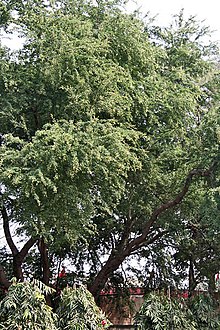Pithecellobium dulce
| Pithecellobium dulce | |
|---|---|
 |
|
| In Kolkata, West Bengal (India) | |
 |
|
| ripe Pithecellobium dulce bean | |
| Scientific classification | |
| Kingdom: | Plantae |
| (unranked): | Angiosperms |
| (unranked): | Eudicots |
| (unranked): | Rosids |
| Order: | Fabales |
| Family: | Fabaceae |
| Genus: | Pithecellobium |
| Species: | P. dulce |
| Binomial name | |
|
Pithecellobium dulce (Roxb.) Benth. |
|
Pithecellobium dulce is a species of flowering plant in the pea family, Fabaceae, that is native to the Pacific Coast and adjacent highlands of Mexico, Central America, and northern South America. It is an Introduced species and extensively naturalised in the Caribbean, Florida, Guam, India, Bangladesh and the Philippines. It is considered an invasive species in Hawaii.
Pithecellobium dulce is a tree that reaches a height of about 10 to 15 m (33 to 49 ft). Its trunk is spiny and its leaves are bipinnate. Each pinna has a single pair of ovate-oblong leaflets that are about 2 to 4 cm (0.79 to 1.57 in) long. The flowers are greenish-white, fragrant, sessile and reach about 12 cm (4.7 in) in length, though appear shorter due to coiling. The flowers produce a pod, which turns pink when ripe and opens to expose an edible pulp. The pulp contains black shiny seeds that are circular and flat.
The seed is dispersed via birds that feed on the sweet pulp. The tree is drought resistant and can survive in dry lands from sea level to an elevation of 1,500 m (4,900 ft), making it suitable for cultivation as a street tree.
The seed pods contain a sweet and sour pulp that which in Mexico is eaten raw as an accompaniment to various meat dishes and used as a base for drinks with sugar and water (agua de huamúchil). The seeds are also edible and refined to extract oil, which amounts to 10% of their weight. They also contain 28% protein.
...
Wikipedia

